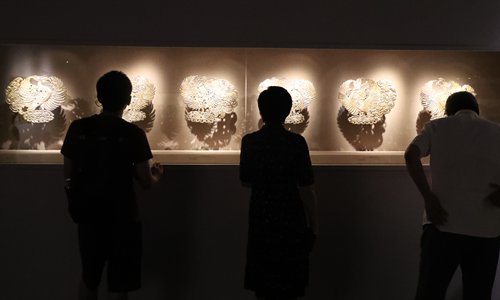HOME >> ARTS
China-US exhibition in Dunhuang tells the story of Tibetan Tubo Kingdom and Silk Road
By Bi Mengying Source:Global Times Published: 2019/7/22 16:23:40

Visitors explore the Cultural Exchange Along the Silk Road: Masterpieces of the Tubo Period (7th-9th Century) exhibition in Dunhuang, Northwest China's Gansu Province. Photo: Xinhua
An exhibition about the ancient Tibetan Tubo Kingdom that opened in Dunhuang, Northwest China's Gansu Province, earlier this month has captured the public's attention.
Items on display at the Cultural Exchange Along the Silk Road: Masterpieces of the Tubo Period (7th-9th Century) exhibition, which will run until October 22, range from paintings, silk products, Buddha statues and other relics that provide valuable insight into research on the ancient Silk Road, the Tubo Kingdom and central Asian history.
The more than 120 cultural relics on display were selected from approximately 30 museums and cultural institutions in China and abroad. Among them, 22 are Chinese cultural institutions such as the Palace Museum and the National Museum of China. International cultural institutions include countries such as the US, Japan, Switzerland and Russia. Many of the exhibited items from these overseas institutions are being displayed in China for the first time.
The Global Times recently sat down with the curator of the exhibition David Pritzker, who went into great detail about the exhibition, the largest display of Tubo artifacts ever held.
One of a kind
Most exhibitions and research on the history and culture of the Silk Road have been focused on the Tang Dynasty (618-907) and regions such as Central Asia, Persia and the Mediterranean Sea. Few have dived deep into the Tubo Kingdom (approximately 618-842), a multi-ethnic regime established by the Tubo people with other ethnic groups and tribes in the Qinghai-Tibet Plateau and its neighboring areas.
Under the guidance of China's National Cultural Heritage Administration, the exhibition is co-hosted by the Dunhuang Academy China and the Pritzker Art Collaborative in the US. It aims to present the cultural exchanges that took place between the Tubo people and their neighbors along the Silk Road during the 7th to 9th centuries across seven sections.
"The whole concept of the Silk Road, and the way it really touches on all of human history across Eurasia, is really powerful. And I think that there is no end to the complexity of it. But to bring the Tibetan Plateau more into the viewpoint of the whole Silk Road and to more periods of engagement in the Silk Road, and in Central Asia, is an exciting topic," Pritzker, director of the Pritzker Art Collaborative, told the Global Times.
"It is not a topic has been widely presented or discussed. It's definitely something people have been studying for some time. But to put this kind of exhibition in the oasis of Dunhuang and at the foot of the Mogao Grottoes, it's a special exhibition," he added.
Story of Princess Wencheng
The exhibition presents a picture of how cultural exchanges along the Silk Road contributed to the culture of the Tubo Kingdom, such as the introduction of Buddhism from India, the impact craftsmen from Nepal had on art and the Tang Dynasty's impact regarding its political system, astrology, medicine, culture and arts.
Speaking of the cultural exchange between Tang Dynasty and Tubo Kingdom, the story of Princess Wencheng of the Tang Dynasty is probably what first comes to mind for many Chinese. She traveled from Chang'an, today's Xi'an in Shaanxi Province, Northwest China, to marry Songtsen Gampo, the King of Tubo. The marriage brought silk clothing, books, agricultural tools and craftsmen to the region.
A part of the collection from the Palace Museum, the rarely seen masterpiece Bunian Tu is on display at the exhibition. Also known as Emperor Taizong Receiving the Tibetan Envoy, the 1.3-meter-long silk scroll is widely believed to have been painted by Tang Dynasty artist and official Yan Liben. The painting shows Emperor Taizong of Tang meeting with Gar Tongtsen Yulsung, the envoy of Songtsen Gampo, after accepting the king's proposal to marry Taizong's daughter Princess Wencheng.
Aside from the masterpiece, a pair of 13th to 14th century copper statues of the married couple from the Dunhuang Academy are also on display at the exhibition.
Working together
"This exhibition, there is so much diplomacy, exchange and collaboration and communication that is built up with Dunhuang Academy and with Cultural Relics Department," said Pritzker.
Considering the large number of museums both in and outside of China, and the different engagements from each institutions across different countries, "it was not an easy exhibition to put together," he added.
He further pointed out that translation could be an inhibitor to understanding each other, as he doesn't speak Chinese.
"But I think the longer we worked together… even from the beginning, people had very open, honest and frank conversations around organizing the exhibition. And because of that honesty from the beginning, and the transparency with each other from the beginning, that set the exhibition on a good ground of working together and collaboration," he said.
"For me personally, the title of the exhibition was perfect. Because the cultural exchanges happened in the exhibition was very, very special," concluded Pritzker.
Newspaper headline: Engaging history
Posted in: ART,CULTURE & LEISURE,ARTS FOCUS